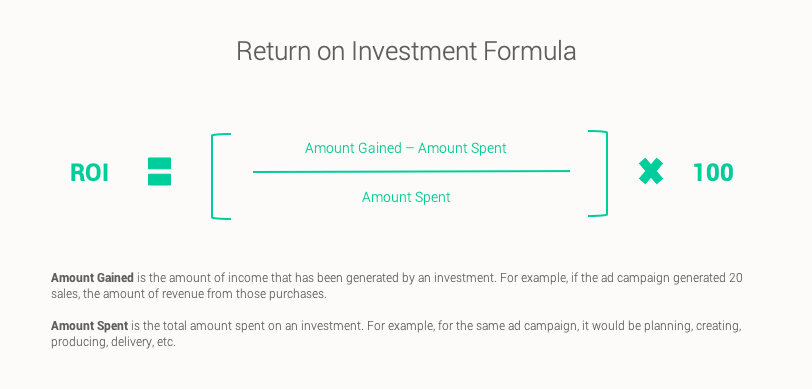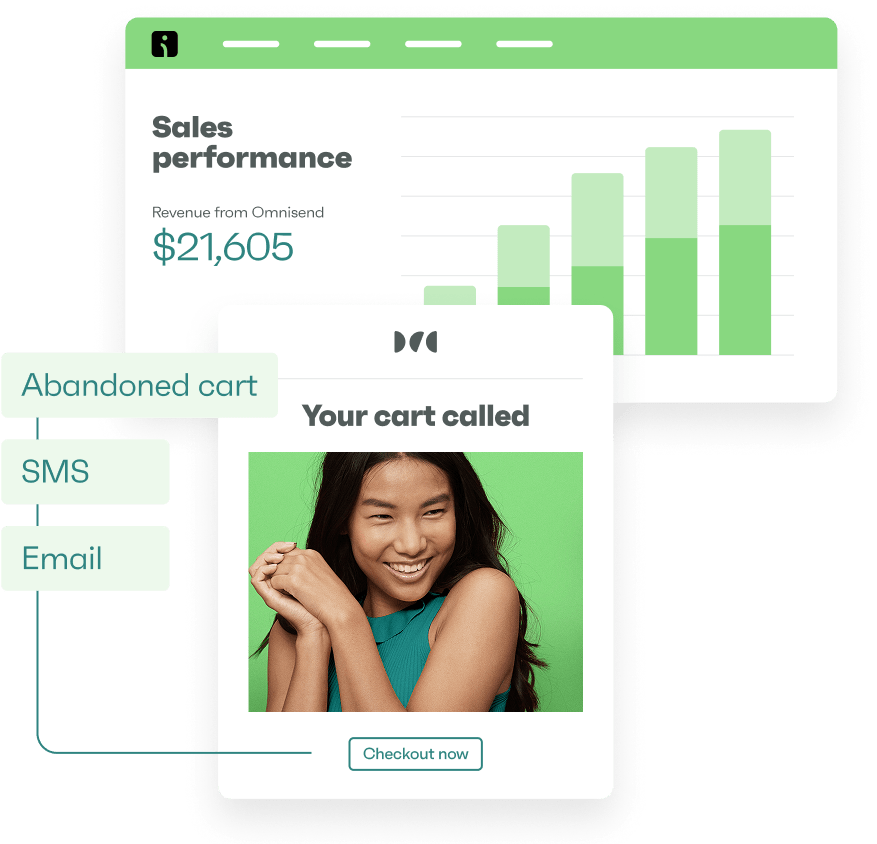
Drive sales on autopilot with ecommerce-focused features
See FeaturesEmail marketing ROI is one of the most discussed metrics in digital marketing, yet it remains one of the most misunderstood. However, without a clear strategy, your campaigns may cost more than they yield in conversions.
When done right, email remains one of the most profitable digital channels. In fact, Omnisend users see an average return of $68 for every dollar spent, making it one of the most cost-effective strategies in ecommerce.
But tapping into that value requires more than sending campaigns. It requires knowing what’s working, what’s wasting the budget, and that increased investment will deliver the greatest return.
Measuring email marketing ROI helps you fine-tune targeting, optimize content, and justify spending with hard data. But what is the ROI on email marketing?
In this guide, we’ll detail how to calculate your email marketing ROI, explain why it matters, and outline the factors that affect it. Monitoring ROI can help you improve your business’s marketing activities and, therefore, make more money. Try our email ROI calculator to see what kind of returns you can get from your email marketing campaigns.
Calculate the return on investment (ROI) of your previous or next email marketing campaign to see how valuable email can be. Use our calculator to set your goals, increase your ROI, and plan your future marketing campaigns.
Choose the currency you’d like to use to calculate your email marketing ROI.
Enter the total number of contacts that you’re sending the campaign to.
Enter the cost for sending this single campaign. (Divide your monthly cost by the total campaigns sent per month.)
Enter the total value of your sales for this campaign.
- Cost per Subscriber -
- Total Revenue -
- Total Profit -
- Revenue per Email -
-
Quick sign up | No credit card required
What is email marketing ROI?
Email marketing ROI refers to the revenue generated from the money spent on email marketing.
In other words, it measures how much profit you make for every dollar invested in email marketing. This includes the costs of creating and sending targeted email marketing campaigns, collecting email lists, and other vital aspects of marketing.
What’s an average email marketing ROI?
Before you start measuring your ecommerce email marketing ROI, it’s necessary to have a baseline understanding of how the average email campaign performs. According to multiple studies, the average ROI for email marketing ranges from $36 to $40 for every dollar spent. So, that’s the ROI you should be targeting.
“The ROI we received is partly due to our strong customer loyalty. Our returning customers already made up a significant portion of revenue, but Omnisend allowed us to engage them more effectively through multiple channels. By pairing time-sensitive email promotions with SMS and push notifications, we’ve seen incredible results.”
Shan Jiang
Customer Growth Manager at Kate Backdrop
Kate Backdrop achieved an impressive 1:300 ROI using omnichannel marketing strategies. Read the full case study.
What is a good email marketing ROI?
Naturally, marketers looking to improve their email marketing are interested in learning what a good ROI for ecommerce is, especially since opinions on what’s considered “good” can vary.
The right platform can help your email marketing ROI increase even further. Omnisend’s US merchants see an average ROI of $68 for each dollar spent — approximately double the average for email marketing.
How do you calculate ROI in email marketing?
After identifying how much you spend on email marketing and how much you earn, you can calculate your email marketing ROI.
Calculating requires a simple equation:
- Subtract the money gained from the money spent
- Divide that number by the money spent
- Check out the ROI of your email marketing
Here’s the shorthand version of the email marketing ROI calculation formula:
(Gained – Spent) / Spent = ROI
To give an example, if your business earned $1,000 from an email marketing campaign after spending $100, then you would have an ROI of $9. This means you earned $9 for every dollar spent on the email marketing campaign.
If you prefer to work with percentages, use the equation in the image below to calculate your ROI percentage. Multiplying the previous equation by 100 will let you know the percentage increase in your money. In short, earning $1,000 from spending $100 would net a 900% ROI:

Email marketing ROI statistics
When marketers ask what is the average return on email marketing, the answer consistently places email among the highest-ROI channels in digital strategy.
- Multiple sources show that email marketing delivers an average ROI of $42 for every dollar spent. This impressive return rate spans different business sectors and consistently outperforms many other digital marketing investments, making it a cornerstone of successful marketing strategies.
- For some, that figure climbs even higher. Omnisend data indicates that its US merchants see returns of $68 per dollar. That’s nearly double the global average. This superior performance shows that the right platform and strategy can significantly amplify returns beyond industry standards.
- Building on this foundation, Omnisend data indicates that email campaign click-to-conversion rates reached 27.6% in 2024. This is a clear demonstration of email’s exceptional ability to turn engaged subscribers into paying customers. This high conversion rate directly contributes to the strong ROI figures businesses experience across their email campaigns.
- Automated emails accounted for 37% of all email-generated sales, according to Omnisend data, despite making up only 2% of total sends. This disproportionate impact highlights the power of behavioral triggers and lifecycle automation. Conversely, the efficiency of automated sequences explains why they deliver such an exceptional email marketing return on investment compared to one-off campaigns.
- Looking ahead, the financial upside is hard to ignore. Statista projects that email marketing revenue will surge by 286.6%, growing from $9.7 billion in 2024 to $37.5 billion by 2032. This growth trajectory mirrors the channel’s expanding role in omnichannel strategies and its adaptability to AI-driven personalization. Together, these factors reinforce email’s position as a key driver of revenue.
- Finally, email remains the preferred communication method for 79% of consumers worldwide, according to Twilio. However, preferences vary by region and age group. This is a reminder that segmentation and localization are key to maximizing ROI across diverse audiences and ensuring campaigns resonate with target demographics.
Quick sign up | No credit card required
Why ROI matters
There are many reasons why email ROI is important and why you should monitor it continuously. Keeping track of ROI:
- Gives you an idea of your campaign’s profitability
- Enables you to tweak your campaigns based on what works to drive better returns
- Helps with the optimal allocation of your financial resources
- Can show tangible results to stakeholders
 | “Omnisend was paying for itself in the first two weeks of use. Now, we’re seeing a 40x return across all campaigns and automations.” Marc Trimble Digital marketing manager at Duke Cannon |
What factors affect email marketing ROI?
Understanding what drives your email marketing ROI helps you optimize campaigns and make smarter use of every marketing dollar. From your targeting approach to the tools you use, several key elements influence how much return you generate. These include:
- Audience segmentation: Segmented campaigns consistently outperform generic untargeted emails. By sending tailored content to specific groups, you can increase open rates, conversions, and overall email marketing ROI.
- Automation and workflows: Automated emails, like welcome sequences or cart reminders, deliver consistent engagement without added effort. They’re not only efficient but also proven to produce higher ROI than manual sends.
- Testing and optimization: A/B testing elements like subject lines, send times, layouts, and offers helps you learn what resonates. Ongoing refinement based on real data drives better performance, higher conversions, and stronger email marketing ROI over time.
- List quality and hygiene: A clean, engaged list ensures better deliverability and performance. Removing inactive subscribers and validating emails helps maintain high email marketing ROI and protects sender reputation.
- Email content and design: Engaging, relevant content keeps your audience opening and clicking. Poor copy or design, on the other hand, increases bounce rates and leads to unsubscribes, hurting your email marketing ROI.
- Channel integration: Integrating email with SMS, push, or retargeting amplifies impact. Omnichannel campaigns can increase your ROI of email marketing by keeping your brand top of mind across touchpoints.
- Mobile optimization: With most emails now opened on mobile, responsive design is non-negotiable. Emails that don’t render well on small screens often lead to lost revenue opportunities.
- Timing and frequency: Sending emails too frequently can cause fatigue, while sending too few can lead to disengagement. Striking the right balance is key to driving click-through rates and conversions.
- Call to action effectiveness: Clear, compelling CTAs eliminate hesitation and guide subscribers to take action. In contrast, weak or vague CTAs can significantly reduce your conversion rates.
“All in all, we saw that with Omnisend our clients get the highest ROI. They pay a couple of hundred a month and get tens of thousands in return — just from automations. Some may still think that email marketing is annoying, but if you send relevant information, your clients will be happy and enthusiastic.”
Alvaro Diaz-Rato
Founder & Digital Consultant at STRAT Agency
Relevant, well-timed automation led to higher engagement and exceptional returns. Read the full case study.
How to improve your email marketing ROI
If your email marketing ROI is lagging behind your competitors or is only in the average range, it’s a good idea to consider ways to increase it.
Here are a few strategies you can use to improve your email marketing ROI:
- Build an email list continuously
- Write effective subject lines and email preheaders
- Design personalized emails thanks to targeting
- Send browse and product abandonment emails
- Clean your email list regularly
- Experiment with your email CTAs
- Check analytics and performance
- Do A/B testing
- Adjust and optimize your email campaigns
Remember that implementing new email marketing strategies can only take you so far. You need the right set of tools to help you execute these tactics and get a higher ROI. Omnisend offers multiple interactive tools that can help you speed things up:
Ready to turn emails into revenue?
Email marketing is one of the most important channels for communicating with customers. By sending emails to customers (or potential customers) who have opted in, you can encourage purchases and engagement. As you refine your strategies and optimize your approach, you’ll only see your email marketing’s ROI increase.
Even if your ROI lowers as you make changes, don’t panic! This means you should revert the changes you made since they don’t appeal to your audience. On top of that, you learned what your customers didn’t like, information that’s invaluable as you tweak your marketing strategies.
It all comes down to providing the services, products, and information your customers want. By keeping this information in mind, you’ll not only maintain an email list with happy, engaged customers, but you’ll also continue to improve your ROI.
FAQs
Yes, tools are available to help you calculate and track email marketing ROI. Omnisend, for example, provides an email marketing ROI calculator specifically designed to help ecommerce businesses understand the return they get from each email campaign they send.
This tool can assist companies in tracking key performance indicators, such as revenue generated, customer engagement, and conversion rates, to calculate the effectiveness of email marketing efforts.
A high-quality list leads to better engagement metrics (open rates, click-through rates, conversions) because it targets the right audience. This can result in higher ROI, as emails are more likely to reach recipients who are genuinely interested and more likely to buy.
In contrast, a low-quality list can lead to higher bounce rates, more unsubscribes, and spam complaints, all of which can decrease ROI.
Email marketing has one of the highest returns on investment (ROI) among all marketing channels. On average, businesses earn $42 for every $1 spent on email marketing, making it far more effective than many traditional and digital marketing channels.
To measure email marketing ROI, you need to track the total amount of money you spend on your email marketing efforts and the revenue you generate as a result.
TABLE OF CONTENTS
TABLE OF CONTENTS


No fluff, no spam, no corporate filler. Just a friendly letter, twice a month.

 OFFER
OFFER









